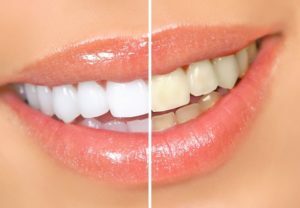 Homemade whitening can be a double-edged sword. On the one hand, you can achieve the desired effect in the form of a virtually Hollywood smile, on the other - to cause irreparable harm to the enamel or mucous tissues. Therefore, before making the teeth white at home with the use of folk or pharmacy means, it is important to correlate the benefits and harm, given the contra-indications and recommendations described below.
Homemade whitening can be a double-edged sword. On the one hand, you can achieve the desired effect in the form of a virtually Hollywood smile, on the other - to cause irreparable harm to the enamel or mucous tissues. Therefore, before making the teeth white at home with the use of folk or pharmacy means, it is important to correlate the benefits and harm, given the contra-indications and recommendations described below.
In addition, it should be noted that at home it is impossible to instantly achieve whiteness of whiteness. Usually the result is manifested gradually, the maximum visual effect is provided after about a month.
Contents of
- What affects whiteness and color of teeth
- Who needs teeth whitening?
- When is the procedure not recommended?
- Folk remedies
- Wood ash
- Soda
- Hydrogen peroxide
- Strawberry
- How to whiten your teeth with the Opalescence system?
- Possible negative consequences and their prevention
- Reviews
What affects the whiteness and color of teeth
Ideal white enamel is extremely rare. Most often it has a naturally yellowish, grayish or bluish tinge. Such features are caused by the genotype similar to the color of the hair or eyes. According to the doctors themselves dentists, a darker natural shade of enamel indicates the health and strength of the teeth.
In addition to the natural features, the color of the enamel is due to the influence of various external causes, which include:
-
 Forming a deeply penetrating plaque due to frequent consumption of food beverages and products with dyes;
Forming a deeply penetrating plaque due to frequent consumption of food beverages and products with dyes; - Regular smoking, provoking so-called discoloritis, which is characterized by deep uneven discoloration of the tooth;
- Frequent consumption of strong tea and coffee;
- Injury of teeth or treatment of pulpitis with filling of dental canals;
-
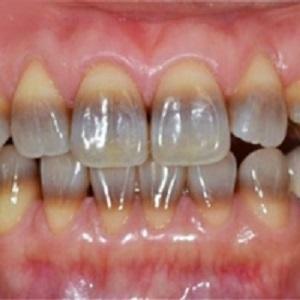 Admission in childhood( usually up to 8 years) of drugs with tetracycline or ingestion of this substance in the body during the period of intrauterine development;
Admission in childhood( usually up to 8 years) of drugs with tetracycline or ingestion of this substance in the body during the period of intrauterine development; - Accumulation in the body of excess fluoride as a result of its continued intake with poor-quality water or food. As a result, fluorosis develops, which manifests itself in the form of speckled teeth with the appearance of a yellow pigment.
In addition to these reasons, the provoking yellowing of teeth is the consumption of large quantities of sweets.
Because of the increased intake of easily assimilated carbohydrates, microorganisms present in the oral cavity begin to actively release the products of vital activity that destroy the surface of the tooth, thinning the enamel. As a result, the dentin hidden under the enamel, which has a yellow color, appears outward.
Who needs to whiten their teeth?
Dentists recommend to think about bleaching only to those people who are absolutely sure of the health of their gums and the absence of dental defects in the form of caries, chips and other enamel. The most effective results are achieved if the teeth have a yellowish tinge and the process is not started.
 In the presence of carious cavities or tartar, first the oral cavity is sanitized. Such measures are necessary not only to prevent the development of inflammation after bleaching, but also to accurately assess the natural color of the enamel, which can be distorted under the influence of these factors.
In the presence of carious cavities or tartar, first the oral cavity is sanitized. Such measures are necessary not only to prevent the development of inflammation after bleaching, but also to accurately assess the natural color of the enamel, which can be distorted under the influence of these factors.
A good result is bleaching in the diagnosis of such a blemish as hypoplasia, when, due to underdevelopment of dental tissues, whitish or yellow spots of the same size have clear contours. As a rule, pathology affects the same teeth. The procedure is shown if the defects are visible during a conversation or a smile.
When is the procedure not recommended?
There are the following contraindications for the procedure:
- Adolescence up to 14 years;
-
 Pregnancy and lactation period;
Pregnancy and lactation period; - Hypersensitivity of tooth enamel;
- Installation of veneers, crowns on the front teeth, the presence of seals( after the procedure, the difference between whitened natural tooth tissues and artificial structures will be noticeable);
- Internal dyeing of the teeth, when the bluish color of the enamel becomes the result of filling the root canals( this phenomenon is considered as a gross dentist error and the presence of blood traces in the channels).In this situation, intrachannel whitening is indicated;
- Gray or brown shade of teeth, as the final result does not meet expectations;
- Allergic reaction to the agents used in the process.
Folk remedies
At home, both folk remedies and pharmaceuticals can be used.
Wood Ash
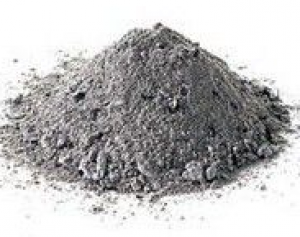 A feature of wood ash is the presence in its composition of potassium hydroxide, which safely whitens the surfaces contacting with it. For domestic use, ashes are used both in pure form and as a mixture with toothpaste. In order to avoid damage to the enamel, a maximum of 2 cleaning per week is carried out.
A feature of wood ash is the presence in its composition of potassium hydroxide, which safely whitens the surfaces contacting with it. For domestic use, ashes are used both in pure form and as a mixture with toothpaste. In order to avoid damage to the enamel, a maximum of 2 cleaning per week is carried out.
It should be noted that ash helps not only to clean the plaque qualitatively, but also to prevent the development of carious processes.
Soda
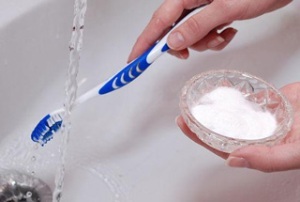 Conventional baking soda present in every home is also an effective whitening agent and helps to remove even persistent plaque. The recipe consists in the following: it is necessary to use soda as an alternative to tooth powder or sprinkle with fine granules the toothpaste applied to the brush before brushing the teeth.
Conventional baking soda present in every home is also an effective whitening agent and helps to remove even persistent plaque. The recipe consists in the following: it is necessary to use soda as an alternative to tooth powder or sprinkle with fine granules the toothpaste applied to the brush before brushing the teeth.
If desired, you can use a soda solution, rubbing the surface of teeth moistened with a cotton swab. In a week, the procedure is carried out only once to avoid injury to the enamel with abrasive crystals and irritation of mucosal tissues.
Hydrogen Peroxide
 This product is highly effective, but it can also cause side effects in the form of a mucus burn. To clean the enamel, the teeth are wiped with cotton wool soaked in peroxide or a cotton swab, treating teeth from all sides. Also, an aqueous rinse aid solution can be used, connecting half a glass of water and 20-30 drops of hydrogen peroxide.
This product is highly effective, but it can also cause side effects in the form of a mucus burn. To clean the enamel, the teeth are wiped with cotton wool soaked in peroxide or a cotton swab, treating teeth from all sides. Also, an aqueous rinse aid solution can be used, connecting half a glass of water and 20-30 drops of hydrogen peroxide.
After treatment, the mouth is thoroughly rinsed with running water. If desired, additional brushing of the teeth with a conventional toothpaste. Do not bleach teeth more than once a week. Possible side effects include a burning sensation of the gums and increased sensitivity of tooth enamel.
How else can I improve the color of my teeth?
Strawberry
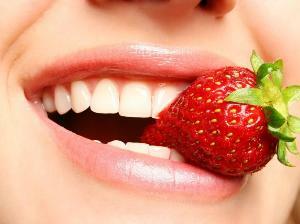 Strawberry or strawberry juice can be safely called the most "delicious" version of teeth whitening without harm to the body. Its action is based on the ability of organic acids to dissolve dental deposits.
Strawberry or strawberry juice can be safely called the most "delicious" version of teeth whitening without harm to the body. Its action is based on the ability of organic acids to dissolve dental deposits.
The cleaning procedure is carried out by rubbing your teeth with crushed berries, using appliques from berry puree or rinsing with freshly squeezed berry juice.
How to whiten teeth with Opalescence system?
The feature of the system of the Opalscence system is the provision of a high aesthetic result with simultaneous strengthening of the teeth due to the saturation of the dental tissues with the necessary mineral substances. Before using, it is advisable to consult a specialist who will give an adequate assessment of the teeth and choose an effective and safe bleaching regimen.
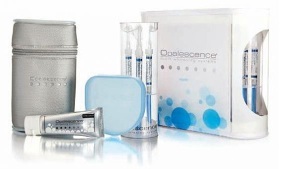 For home use, Opalscence gel TreshWhite is used. The main active substance of the product is 10-20% carbamide peroxide .Also, the composition contains potassium nitrate and fluorine, neutralizing the effect of the oxidizer.
For home use, Opalscence gel TreshWhite is used. The main active substance of the product is 10-20% carbamide peroxide .Also, the composition contains potassium nitrate and fluorine, neutralizing the effect of the oxidizer.
The action of the gel is based on the release of active oxygen and its reaction with the protein bonds present on the stained areas of the dental tissue. As a result of the oxidation reaction, the protein bonds break and the pigment disappears. In a dental office, the reaction can be enhanced by means of a laser or lamp light.
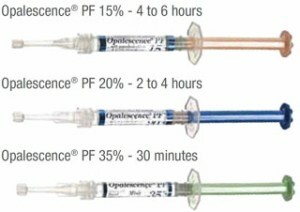 As a rule, a gel cap is put on the teeth in the daytime for the period from half an hour to 2 hours of or used for the whole .Kapy may be present in the kit or be manufactured individually by a dentist in the dental impression. After the first application, a visual effect is noticeable. To achieve the maximum result it is possible after 7-10 days .
As a rule, a gel cap is put on the teeth in the daytime for the period from half an hour to 2 hours of or used for the whole .Kapy may be present in the kit or be manufactured individually by a dentist in the dental impression. After the first application, a visual effect is noticeable. To achieve the maximum result it is possible after 7-10 days .
In the presence of such side effects as soreness of the gums or teeth, intolerance to too hot or cold food procedures should be discontinued. If the course is completed before the end, during 14 days should adhere to the colorless diet , eliminating the use of products rich color, strong tea, coffee and food with dyes.
The duration of the achieved result is from 6 months to 3 years and depends on the individual characteristics.
Possible negative consequences and their prevention
If the rules of procedure are not observed, the following negative events can occur:
- Gum burns;
-
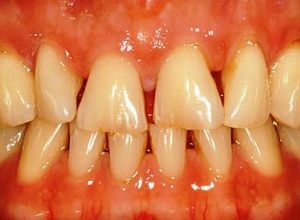
Periodontitis
Severe pain and active tooth decay due to the ingress of bleach into the carious cavity or microcracks present on the enamel;
- Development of periodontitis and gingivitis;
- Thinning and subsequent destruction of tooth enamel( the cause may be a strong concentration of the active substance);
- Damage to the root of the tooth( if the level of the gum is below acceptable);
- No desired result.
To prevent such undesirable consequences, always bleach only after complete sanitation of the mouth and removal of all defects. If you plan to use kapy, it is better to use non-standard variants, but models created from molds of your own teeth that accurately repeat the outlines of teeth without affecting the gum tissue. In addition, the following points should be considered:
-
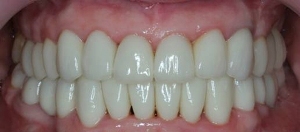 Tooth enamel must be thick enough and strong( only the dentist can assess its condition);
Tooth enamel must be thick enough and strong( only the dentist can assess its condition); - The yellowness to be removed must be located only in the superficial part of the tooth structure, otherwise the desired result will not be achieved;
- It is important to exclude all possible pathologies of the gums by evaluating the conditions of the alveolar processes surrounding the tooth root of the tissues( periodontal);
- It is necessary to inspect the seals, assessing the density of their adherence to the crown part of the tooth, excluding microcracks and gaps.
Reviews
I really liked the Opalscence system, so I plan to use this option of home whitening in the future. Earlier my teeth were yellow, now they just shine with white. However, during the procedure provoked a small burn of the gums, because due to the large size of the cap, a part of the gel hit the gum tissue. As a result, whitish sores formed, which bleed and complicated the process of food intake. Carrying out the procedure again, eliminated such a negative moment and did 2-4 day breaks between sessions.
Valeria, Moscow region
Not entirely satisfied with the Opalscence system. It may be superior to other home remedies, but, in my opinion, there is no reason for especial delight. In my case, the whitening occurred unevenly, and the yellow pigment remained near the edge of the gums, because because of fear of scorching the gum I did not fully wear the kapa on my teeth. As a result, she finished the process with a whitening pencil to smooth out the difference.
Tatiana, Moscow
I regularly use baking soda for teeth whitening. So far, only a positive result can be noted. As for injuries and hypersensitivity, such phenomena are completely absent. However, I do not use soda in its pure form, but I use it together with paste not more than once a week. Initially, I tried to clean it every week with a mixture of salt, soda and hydrogen peroxide, but because of the discomfort in my teeth, I stopped trying.
Valentine, Omsk
I just love strawberries, that's why I use it not only for food, but also for cosmetic purposes, in particular, for teeth whitening. To do this, just grind the ripe berry in the teeth. After a while, I rinse my mouth with running water. The result is noticeable at once - the teeth of the footprint turn white. Strawberries are especially effective in the loss of teeth whiteness due to excessive coffee consumption.
Kira, Smolensk
